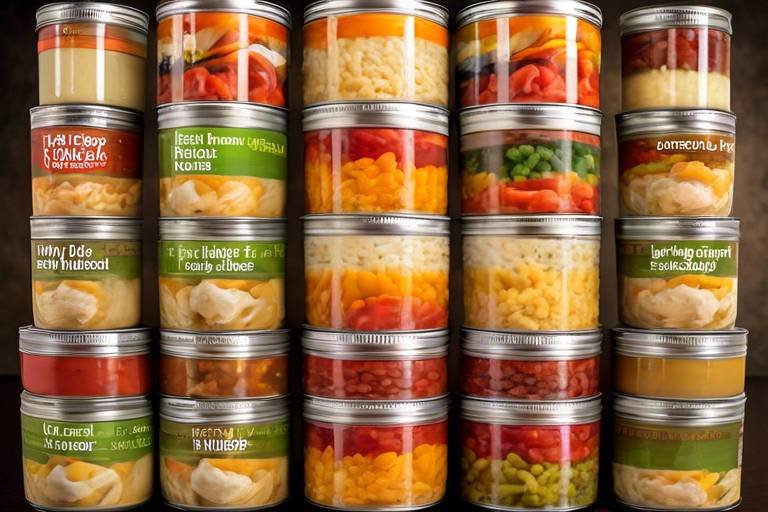Making Healthy Choices While Dining Out as a Family
Dining out as a family can be a delightful experience, filled with laughter, conversation, and of course, delicious food. However, it can also pose challenges when it comes to making healthy choices. With tempting menus and enticing aromas, it’s easy to stray from nutritious options. But fear not! This article is here to guide you through the maze of restaurant offerings, ensuring that your family can enjoy a satisfying meal without compromising on health. Think of it as a treasure hunt, where the goal is to find the gems of healthy eating amidst a sea of tantalizing but less nutritious options.
When you step into a restaurant, the first thing that hits you is the vibrant atmosphere and the overwhelming array of choices. It can feel like being a kid in a candy store, but instead of candy, it’s all about the food! The key is to approach the menu with a discerning eye. Look for items that are grilled, baked, or steamed rather than fried or heavily sauced. This is where understanding restaurant menus comes into play. By learning to read between the lines, you can uncover nutritious options that everyone in the family will love.
Portion control is another crucial aspect of dining out. Restaurants often serve generous portions that can lead to overeating. A good strategy is to share dishes or order smaller plates. Think of it as a buffet where you can sample a little bit of everything without going overboard. It’s not just about what you eat; it’s also about how much you eat. By practicing portion control, you can enjoy your favorite meals while keeping your health in check.
Beverage choices can make or break a meal. Opting for water, unsweetened tea, or other low-calorie drinks can significantly reduce your calorie intake. Did you know that some sugary drinks can contain as many calories as a dessert? By choosing healthier beverages, you’ll be amazed at how much better you feel after your meal. Plus, it’s a simple way to cut down on unnecessary sugar.
Starters can set the tone for your meal, so why not make them count? Instead of diving into fried calamari or cheesy nachos, consider options like a fresh salad or vegetable soup. These choices not only tantalize your taste buds but also pave the way for a healthier main course. Remember, the first impression matters, and starting with a nutritious appetizer can lead to better choices throughout the meal.
When it comes to side dishes, think of them as the supporting cast in your meal. They should complement your main dish while adding nutritional value. Opt for sides like steamed vegetables, quinoa, or brown rice instead of fries or creamy coleslaw. This not only enhances the overall meal but also contributes to a balanced diet, making your dining experience both enjoyable and healthy.
Special dietary needs should never be an afterthought when dining out. Whether you have a family member with allergies, gluten intolerance, or specific dietary preferences, most restaurants are willing to accommodate these needs. Don’t hesitate to ask questions or request modifications to dishes. It’s all about ensuring that everyone at the table can enjoy their meal without worry.
Mindful eating is a practice that can transform your dining experience. Instead of rushing through your meal, take the time to savor each bite. This not only enhances your enjoyment but also helps you recognize when you’re full. It’s like a dance between your body and your food—one that promotes awareness and appreciation for what you’re consuming.
Planning ahead is like having a roadmap for your dining adventure. Before heading out, take a moment to research the restaurant and review their menu online. This allows you to identify healthy options and even make a plan for what you’ll order. By being proactive, you’ll set yourself up for success, making it easier to stick to your health goals.
Lastly, it’s essential to encourage healthy choices in kids. Make it a fun challenge to try new vegetables or healthier dishes when dining out. By involving them in the decision-making process, you can foster a sense of accountability and excitement around nutritious eating. Remember, the habits they form now will stick with them for life!
- What are some healthy options to look for on a restaurant menu?
Look for dishes that are grilled, baked, or steamed. Salads with lean proteins, vegetable soups, and whole grain sides are also great choices. - How can I manage portion sizes when dining out?
Consider sharing dishes with family members or ordering smaller plates. You can also ask for a to-go box at the beginning of the meal and place half of your dish inside to enjoy later. - What drinks should I avoid when eating out?
Steer clear of sugary sodas, sweetened teas, and creamy cocktails. Opt for water, unsweetened iced tea, or sparkling water with lemon instead. - How can I ensure my dietary restrictions are accommodated?
Always communicate your dietary needs to the server. Most restaurants are happy to modify dishes or suggest alternatives.

Understanding Restaurant Menus
When it comes to dining out with the family, can make all the difference between a healthy meal and a calorie bomb. Imagine walking into a restaurant, the aroma of delicious food wafting through the air, and you’re faced with a menu that looks like a foreign language. Don’t worry! With a little know-how, you can navigate those menus like a pro. First off, take a moment to look for keywords that indicate healthier options. Words like grilled, steamed, or roasted usually suggest a healthier cooking method compared to fried or crispy.
Another crucial aspect is to pay attention to the descriptions of the dishes. Some restaurants offer detailed descriptions that can help you identify hidden ingredients or sauces that might add unnecessary calories. For example, if a dish is described as “sautéed in butter,” it might not be the best choice if you're trying to keep things light. Instead, look for dishes that highlight fresh ingredients, like “seasonal vegetables” or “lean proteins.”
Don’t forget to check out the nutritional information if it’s available. Many restaurants now provide calorie counts or nutritional breakdowns on their menus or websites. This information can be a game-changer. It allows you to make informed choices and avoid those sneaky calories that can add up faster than you think. For instance, did you know that a typical restaurant burger can pack in over 1,000 calories? That’s more than half of the daily calorie intake for many people!
Also, keep an eye on portion sizes. Many restaurants serve portions that are enough to feed a small army. It’s easy to get carried away, especially when everything looks so tempting. If the portions seem larger than what your family typically eats, consider sharing dishes or asking for a to-go box right away to save half for later. This way, you can enjoy your meal without the guilt of overeating.
Finally, don’t hesitate to ask your server for recommendations. They often know which dishes are popular and can guide you towards healthier choices. A simple question like, “What’s the healthiest option on the menu?” can lead you to a delightful dish that you might not have considered otherwise.
In summary, understanding restaurant menus is about being proactive and informed. By looking for healthy keywords, being aware of portion sizes, checking nutritional information, and asking for help when needed, you can ensure that your family enjoys a nutritious meal that satisfies everyone’s taste buds. So next time you’re out, remember: a little knowledge goes a long way in making healthy dining choices!
- How can I find healthy options on a menu? Look for keywords like grilled, baked, or steamed, and avoid fried or creamy dishes.
- Are portion sizes at restaurants always large? Yes, many restaurants serve larger portions. Consider sharing or taking leftovers home.
- What should I do if I have dietary restrictions? Always inform your server about any dietary needs; they can guide you to suitable options.
- Can I ask for modifications to a dish? Absolutely! Most restaurants are happy to accommodate special requests.

Portion Control Tips
When it comes to dining out as a family, portion control can be a game changer. It’s all too easy to get swept away by the delicious aroma of food and the excitement of eating out, leading to oversized portions that can derail healthy eating habits. So, how do we navigate this culinary landscape without sacrificing flavor or enjoyment? Here are some practical tips that can help!
First off, sharing is caring! One of the best strategies for managing portion sizes is to share dishes among family members. Not only does this allow everyone to taste a variety of flavors, but it also helps to keep portions in check. Think of it as a mini buffet right at your table! For instance, if you order an entrée that serves two, consider splitting it with your partner or children. This way, you can enjoy a hearty meal without overindulging.
Another great tip is to ask for smaller portions. Many restaurants are more than willing to accommodate requests for smaller servings or half-portions, especially for children. This not only helps with portion control but also reduces food waste. If a restaurant doesn’t offer this option, you can always ask for a take-home box right when your meal arrives. This allows you to set aside a portion for later, ensuring that you won’t be tempted to finish everything on your plate.
Additionally, it’s important to be mindful of the types of dishes you choose. Opt for meals that are loaded with vegetables, lean proteins, and whole grains. These options tend to be more filling and nutritious, which can naturally help you feel satisfied with smaller portions. For instance, a colorful salad topped with grilled chicken can be both filling and healthy, allowing you to enjoy a generous serving without the guilt.
Let’s not forget about the power of mindful eating. Take the time to savor each bite, and pay attention to your body's hunger signals. Sometimes, we eat out of habit rather than hunger. By slowing down and enjoying your meal, you’ll be more in tune with your body’s cues, making it easier to stop when you’re full. Try putting your fork down between bites, engaging in conversation, or even taking a sip of water to help pace yourself.
Finally, consider creating a family rule about portion sizes. For example, you could agree that everyone will take a small portion of their chosen meal first, and then decide if they want more. This encourages everyone to think about their hunger levels and helps to prevent the temptation of going back for seconds too quickly. It’s a fun way to make healthy choices together as a family!
In summary, portion control doesn’t have to be daunting. With a few simple strategies, you can enjoy a delicious meal out while keeping your health goals in check. Remember, dining out is about enjoying the experience together, not just the food. By being mindful of your choices and practicing portion control, you can create a positive dining experience that everyone will love.
Q: How can I tell if a portion is too large?
A: A good rule of thumb is to use your hand as a guide. A portion of protein should be about the size of your palm, while carbohydrates should be about the size of your fist. Vegetables can fill half your plate!
Q: What if my kids are picky eaters?
A: Encourage them to try a little bit of everything. You can even make it a fun game by letting them pick a small portion of an unfamiliar dish to taste. This way, they can explore new flavors without feeling overwhelmed.
Q: Are there specific cuisines that are better for portion control?
A: Yes! Cuisines that emphasize vegetables, lean proteins, and whole grains, like Mediterranean or Asian cuisine, often offer healthier options that can help with portion control.

Choosing Healthier Beverages
When dining out, it’s easy to overlook the impact of our beverage choices. We often think of drinks as mere accompaniments to our meals, but they can significantly influence our overall health. Imagine sipping on a sugary soda while your meal is packed with fresh, nutritious ingredients. It’s like planting a beautiful garden and then letting weeds take over! To truly embrace a healthy lifestyle, it’s important to make informed decisions about what we drink.
First off, let’s talk about the classic choices: soda and sweetened beverages. These drinks can be loaded with sugar, often containing more calories than we realize. For instance, a regular soda can have upwards of 150 calories per serving, not to mention the added sugars that can lead to energy crashes later. Instead of reaching for that fizzy temptation, why not consider alternatives that are just as refreshing but far more nourishing?
One great option is to choose water. It’s the ultimate thirst quencher, calorie-free, and essential for our bodies. If plain water feels a bit too boring, jazz it up with some lemon, cucumber, or mint leaves. Flavored sparkling water is also a fantastic choice, providing that bubbly sensation without the added sugars. You can even ask for a splash of fruit juice in your water for a hint of sweetness without going overboard.
Another popular choice is tea, which can be a delicious and healthy alternative. Whether you prefer iced or hot, tea comes in various flavors and can be packed with antioxidants. Herbal teas, in particular, can offer a range of health benefits without any caffeine or calories. If you’re feeling adventurous, try ordering a chai or matcha latte made with low-fat milk or a dairy alternative. It’s like a warm hug in a cup!
Now, let’s not forget about smoothies. These can be a delightful way to incorporate fruits and vegetables into your meal. However, be cautious! Some smoothies can be deceivingly high in calories and sugars, especially those made with ice cream or sweetened yogurts. Opt for smoothies that use whole fruits, leafy greens, and unsweetened almond milk or yogurt. This way, you’re nourishing your body without the guilt!
When dining out, it’s also worth paying attention to the beverage menu. Many restaurants now offer health-conscious options, such as fresh-pressed juices or low-calorie cocktails. If you’re in the mood for something a little stronger, consider choosing a cocktail made with soda water or tonic instead of sugary mixers. You can also ask for your drinks to be made with less sugar or to have them served in smaller portions. It’s all about making choices that align with your health goals.
Lastly, let’s discuss the importance of mindfulness when it comes to drinking. Just as we practice mindful eating, we should also be mindful of our beverages. Take a moment to savor each sip, appreciate the flavors, and listen to your body. Are you truly thirsty, or are you just reaching for something to fill the void? By being aware of our choices, we can cultivate a healthier relationship with food and drink.
In conclusion, choosing healthier beverages while dining out doesn’t have to be a chore. It’s about making small, conscious decisions that can lead to significant changes in our overall health. Remember, every sip counts!
- What are some low-calorie drink options at restaurants? Look for water, unsweetened tea, or sparkling water with a splash of fruit juice.
- Are smoothies always healthy? Not necessarily! Choose smoothies made with whole fruits and vegetables without added sugars.
- How can I reduce sugar in my drinks? Ask for less sugar in cocktails and choose mixers like soda water over sugary options.

Making Smart Appetizer Choices
When it comes to dining out as a family, appetizers can be both a delightful start to your meal and a potential pitfall for your health goals. So how do you navigate the appetizer section of the menu without feeling like you’re diving headfirst into a sea of calorie-laden options? The key lies in making smart choices that not only satisfy your taste buds but also align with your family's health objectives.
First off, it's essential to consider the types of appetizers available. Many restaurants offer a variety of options, from fried calamari to fresh salads. While those crispy fried options might be tempting, they often come with a hefty dose of calories and unhealthy fats. Instead, look for appetizers that are grilled, baked, or steamed. For instance, a caprese salad or a platter of grilled vegetables can be a refreshing and nutritious way to kick off your meal.
Another strategy is to share appetizers. Ordering a couple of different dishes to share among the family can be a fantastic way to sample a variety of flavors without overindulging. Think of it as a mini food adventure! You can try a bruschetta alongside some hummus with veggie sticks. This way, you get to enjoy a range of tastes while keeping portion sizes in check.
Moreover, consider the nutritional content of the appetizers. Many menus now include calorie counts or symbols indicating healthier options. If you see a dish that features whole ingredients, like a seafood ceviche or a quinoa salad, you can feel confident that you’re making a nutritious choice. Don't hesitate to ask your server for recommendations on lighter options or for modifications to existing dishes. Most restaurants are more than happy to accommodate your requests.
Here’s a quick reference table to help you visualize some common appetizers and their healthier counterparts:
| Traditional Appetizer | Healthier Alternative |
|---|---|
| Fried Mozzarella Sticks | Caprese Skewers |
| Buffalo Wings | Grilled Chicken Skewers |
| Nachos with Cheese | Guacamole with Veggie Sticks |
| Stuffed Jalapeños | Stuffed Bell Peppers with Quinoa |
By keeping these tips in mind, you can transform the appetizer phase of your dining experience into a healthy and enjoyable start to your meal. Remember, the goal is to set a positive tone for the rest of your dining experience, so choose wisely and savor each bite!
Q: What are some good appetizers for kids?
A: Kids often enjoy finger foods, so options like vegetable sticks with hummus or fruit skewers can be both fun and healthy.
Q: Are there any appetizers I should avoid altogether?
A: It’s best to steer clear of heavily fried items and those smothered in creamy sauces. Instead, opt for grilled or roasted options whenever possible.
Q: Can I ask for modifications to an appetizer?
A: Absolutely! Most restaurants are willing to accommodate your requests, whether it’s asking for dressing on the side or substituting ingredients for healthier options.

Healthier Side Dishes
When dining out, the side dishes you choose can significantly impact the overall nutritional value of your meal. It's easy to get caught up in the excitement of the main course and overlook the importance of these accompaniments. However, making smart choices for your side dishes can elevate your dining experience while keeping your family's health in check. Think of side dishes as the supporting actors in a movie; they may not be the main star, but they play a crucial role in making the entire meal enjoyable and balanced.
So, what should you look for when selecting side dishes? First, aim for options that are rich in vegetables and whole grains. These foods are not only packed with essential vitamins and minerals but also provide fiber, which can help with digestion and keep you feeling full longer. For instance, consider ordering a side of steamed broccoli or a fresh garden salad. These choices not only add color to your plate but also contribute to your daily vegetable intake.
Another excellent option is to choose whole grain sides, such as quinoa or brown rice. These grains are more nutritious compared to their white counterparts, offering higher fiber content and a wealth of nutrients. If you're at a restaurant that serves baked sweet potatoes, don't hesitate to order one! They are not only delicious but also a fantastic source of vitamins A and C.
To help guide your choices, here’s a quick table comparing common side dishes:
| Side Dish | Nutritional Benefit |
|---|---|
| Steamed Broccoli | High in vitamins C and K, fiber |
| Garden Salad | Rich in antioxidants, low in calories |
| Brown Rice | Whole grain, high in fiber |
| Baked Sweet Potato | High in vitamins A and C, fiber |
Moreover, be cautious of fried or creamy side dishes, such as French fries or macaroni and cheese. While they may be tempting, these options are often loaded with unhealthy fats and calories. Instead, opt for grilled or roasted vegetables, which can add a delightful burst of flavor without the extra calories. If you're unsure about the preparation methods, don't hesitate to ask your server for more information; they are usually happy to help!
Lastly, remember that sharing is caring! If you're dining with family or friends, consider ordering a couple of different side dishes to share. This way, you can sample a variety of flavors while keeping portion sizes in check. Sharing not only makes the meal more enjoyable but also encourages a sense of community and togetherness at the table.
In conclusion, choosing healthier side dishes is a simple yet effective way to enhance your dining experience while staying true to your family's health goals. By focusing on vegetables, whole grains, and mindful portion sizes, you can create a balanced meal that everyone will love. So next time you dine out, remember that the side dishes can be your secret weapon in making nutritious choices!
Q: What are some good side dishes to order at a restaurant?
A: Look for options like steamed vegetables, salads, quinoa, or baked sweet potatoes. These choices are generally healthier and more nutritious compared to fried or creamy sides.
Q: How can I make sure my kids eat their vegetables when dining out?
A: Engage them by allowing them to choose a vegetable side dish. You can also make it fun by sharing and tasting each other's dishes, which encourages them to try new flavors!

Special Dietary Needs
Dining out as a family can be a delightful experience, but it can also pose challenges, especially when it comes to . Whether you're accommodating a family member with food allergies, intolerances, or specific dietary preferences like vegetarianism or veganism, it's essential to navigate restaurant menus with care. Understanding how to communicate your needs to restaurant staff and recognizing which options are safe and suitable can make all the difference in ensuring everyone enjoys their meal.
First and foremost, communication is key. Don’t hesitate to ask your server about ingredients and preparation methods. Many restaurants are more than willing to accommodate special requests, but they need to know what you’re looking for. For instance, if someone in your family is gluten-free, you might want to ask if they have gluten-free bread or pasta available. Moreover, many restaurants now offer allergen menus that clearly label dishes according to common allergens such as nuts, dairy, or shellfish. This can save you time and stress while dining out.
Another critical aspect is to be aware of cross-contamination, especially for those with severe allergies. It’s wise to ask how a dish is prepared and whether it shares cooking surfaces with allergens. A simple question like, “Is the grilled chicken cooked on the same grill as the shrimp?” can provide you with valuable information. Remember, the goal is to enjoy your meal without worrying about potential health risks.
For families with members following vegetarian or vegan diets, many restaurants now offer a variety of options. However, it’s still important to check the ingredients. For instance, some dishes may appear vegetarian but contain animal products like cheese or chicken broth. In this case, you could ask your server if they can modify a dish to meet your dietary needs. This not only ensures that everyone can eat but also encourages restaurants to be more mindful of their ingredient choices.
Here’s a quick table summarizing some common dietary needs and tips for dining out:
| Dietary Need | Tips for Dining Out |
|---|---|
| Gluten-Free | Ask for gluten-free options and inquire about cross-contamination. |
| Vegetarian | Check for animal products and ask for modifications if necessary. |
| Vegan | Ensure no dairy or eggs are included; request vegan sauces or dressings. |
| Nut Allergies | Inquire about nuts in dishes and cross-contact during preparation. |
Lastly, it’s important to educate your family, especially kids, about their dietary needs. Encouraging them to speak up when ordering can empower them and help them feel more involved in the dining experience. By fostering an environment where everyone feels comfortable expressing their dietary preferences, you create a more enjoyable outing for the entire family.
In conclusion, dining out with special dietary needs doesn't have to be daunting. With a bit of preparation, open communication, and a willingness to ask questions, your family can enjoy a delicious meal together while respecting everyone's health needs. Remember, every meal is an opportunity to bond and create lasting memories, so make it count!
Q: How can I find restaurants that cater to specific dietary needs?
A: Many apps and websites specialize in listing restaurants that offer gluten-free, vegan, or allergen-friendly options. You can also check reviews and menus online before visiting.
Q: What should I do if I have a severe food allergy?
A: Always inform your server about your allergy and ask about their protocols for preventing cross-contamination. It’s best to choose restaurants that are known for being allergy-friendly.
Q: Can I request modifications to a dish?
A: Yes! Most restaurants are happy to accommodate requests, such as removing certain ingredients or substituting sides to meet dietary needs.

Mindful Eating Practices
When it comes to dining out as a family, mindful eating is an essential practice that can transform your meal experience from a hurried routine into a delightful occasion. But what exactly does it mean to eat mindfully? It's all about being present during your meal, savoring each bite, and truly appreciating the flavors and textures of the food on your plate. Think of it as a mini-vacation for your senses, where you can escape the hustle and bustle of daily life and focus solely on the act of eating.
One of the first steps to practicing mindful eating is to eliminate distractions. This means putting away your phone, turning off the TV, and engaging in conversation with your family. When you're fully present, you can enjoy your meal more and recognize when you're starting to feel full. Have you ever noticed how often we eat mindlessly while scrolling through our phones? By removing these distractions, you can truly connect with your food and the people you're sharing it with.
Another key aspect of mindful eating is to slow down. In our fast-paced world, it's easy to rush through meals, especially when dining out. But taking your time can make a significant difference. Try putting your fork down between bites, chewing your food thoroughly, and taking a moment to appreciate the flavors. You might even find that you enjoy your meal more and feel satisfied with smaller portions. After all, eating is not just about fueling our bodies; it's about enjoying the experience, much like savoring a fine wine or indulging in a decadent dessert.
Additionally, being aware of your hunger and fullness cues is crucial. Before digging into your meal, take a moment to assess how hungry you really are. Are you genuinely hungry, or are you eating out of habit or boredom? Paying attention to these signals can help you avoid overeating. It's like tuning into your body's own radio station, where you can adjust the volume to match your needs. When you start to feel full, listen to your body and consider wrapping up any leftovers instead of finishing everything on your plate.
Lastly, consider incorporating a family ritual into your dining experience. This could be something as simple as sharing what everyone is grateful for at the table or discussing the best part of your day. Such practices not only foster connection but also enhance the overall dining experience, making meals more meaningful. It’s like turning a regular dinner into a cherished family tradition.
In summary, practicing mindful eating while dining out can lead to a more enjoyable and satisfying meal experience. By eliminating distractions, slowing down, recognizing hunger cues, and creating family rituals, you can transform your dining outings into opportunities for connection, appreciation, and health. So next time you sit down for a meal, take a deep breath, and dive into the delicious world of mindful eating.
- What is mindful eating? Mindful eating is the practice of being fully present and engaged while eating, focusing on the flavors, textures, and sensations of your food.
- How can I practice mindful eating when dining out? You can practice mindful eating by eliminating distractions, slowing down, and paying attention to your hunger and fullness cues.
- Why is mindful eating important for families? Mindful eating encourages healthier eating habits, fosters family connections, and enhances the overall dining experience.
- Can mindful eating help with portion control? Yes, by being more aware of your body's signals, you can better manage portion sizes and avoid overeating.

Planning Ahead for Dining Out
When it comes to dining out, a little bit of planning can go a long way in ensuring that your family makes healthy choices while still enjoying the experience. Imagine walking into a restaurant, feeling confident about your meal choices instead of being overwhelmed by the menu. This is exactly what planning ahead can do for you! By taking some time to research restaurants and review their menus before you arrive, you can set the stage for a delightful culinary adventure that aligns with your family's health goals.
First and foremost, consider using online resources to check out restaurant menus. Most restaurants now publish their menus on their websites, making it easier than ever for you to browse through options from the comfort of your home. Look for sections that highlight healthy options or dishes that are lower in calories and higher in nutrients. This way, you can create a mental shortlist of dishes that appeal to everyone in the family, ensuring that no one feels deprived or left out when it comes time to order.
Another great strategy is to have a family discussion about the dining experience. Before heading out, gather your loved ones and talk about what everyone is in the mood for. This not only involves everyone in the decision-making process but also helps to set expectations. You might say, "How about we look for a place that has great salads or grilled options?" This way, you can steer the conversation towards healthier choices and ensure that everyone is on the same page.
Don't forget to think about portion sizes! Many restaurants serve large portions that can easily lead to overeating. By deciding in advance how much you plan to eat, you can avoid the temptation to finish everything on your plate just because it’s there. If the portions are large, consider sharing dishes with family members or asking for a to-go box at the start of the meal to save some for later. This way, everyone can enjoy their meal without feeling stuffed.
Additionally, consider the timing of your dining experience. If you’re dining out during peak hours, the restaurant may be busier, which can lead to rushed decisions. If possible, try to dine during off-peak hours when the atmosphere is more relaxed. This gives you and your family the time to savor your meal and make thoughtful choices without feeling pressured.
Lastly, don’t shy away from asking questions! When you arrive at the restaurant, feel free to talk to your server about the menu items. Ask about preparation methods, ingredient substitutions, or any specials that might be healthier. Most servers will be more than happy to help you navigate the menu to find options that suit your family's dietary needs.
In summary, planning ahead for dining out is about more than just picking a restaurant; it's about creating an enjoyable experience that aligns with your family's health goals. By researching menus, discussing options, and being proactive about portion sizes and dining times, you can make the most of your outing while still prioritizing nutritious choices. So the next time you plan a family dinner, remember that a little preparation can lead to a lot of satisfaction!
- Why is it important to plan ahead when dining out? Planning ahead helps you make healthier choices and reduces the chances of being overwhelmed by menu options.
- How can I find healthy options on a restaurant menu? Look for sections labeled as "light," "healthy," or "low-calorie." You can also ask your server for recommendations.
- What should I do if my family wants to eat unhealthy food? Have an open discussion about healthier alternatives that everyone can enjoy, and consider sharing dishes to balance indulgence with nutrition.

Encouraging Healthy Choices in Kids
When it comes to dining out, encouraging healthy choices in kids can feel like a daunting task. After all, children are often drawn to the bright colors and enticing smells of fast food and sugary treats. However, with the right strategies, you can help your kids develop a taste for nutritious options while still enjoying the dining experience. Think of it as a culinary adventure where your little ones can discover new flavors and textures!
One effective way to promote healthy eating is to involve your children in the decision-making process. Allow them to help choose the restaurant and look through the menu together. You can ask questions like, “What do you think about trying that grilled chicken salad?” or “How about we share a vegetable stir-fry?” This not only makes them feel included but also encourages them to consider healthier options. It’s like giving them the steering wheel on a road trip; they’ll be more invested in the journey if they feel like they have a say in the destination!
Another strategy is to set a positive example. Kids are keen observers and often mimic the behavior of adults. If they see you opting for a salad instead of fries or choosing water over soda, they are more likely to follow suit. You can also make it a fun challenge by turning it into a game: “Let’s see who can pick the healthiest option from the menu!” This friendly competition can spark excitement and curiosity about healthy foods.
Also, consider introducing a “try something new” rule. Encourage your kids to select at least one unfamiliar item from the menu that they’ve never tried before. This not only expands their palate but also helps them discover new favorites. For instance, if you’re at an Italian restaurant, suggest trying a new vegetable-based dish or a whole grain pasta. Who knows? They might just find a new love for roasted Brussels sprouts!
It's also beneficial to discuss the importance of nutrition in a way that resonates with them. You could explain how certain foods help them grow stronger, run faster, or even think better in school. Use relatable analogies, like comparing vegetables to superhero powers that help them fight off colds and stay healthy. By framing healthy eating as a source of strength, you’re likely to pique their interest and encourage them to make better choices.
Additionally, make sure to celebrate their healthy choices! Positive reinforcement can go a long way. If your child chooses a nutritious dish, give them a high-five or praise them for their choice. You could even create a fun chart at home to track their healthy eating adventures when dining out. Each time they make a healthy choice, they can add a sticker to their chart. Once they reach a certain number of stickers, reward them with a fun outing or a small treat. This not only makes healthy eating fun but also instills a sense of accomplishment.
Finally, remember that balance is key. It’s perfectly fine to indulge in a treat occasionally. Allow your kids to enjoy their favorite dessert or side dish without guilt, as long as it’s not an everyday occurrence. Teaching them moderation is just as important as encouraging healthy choices. After all, life is about enjoying food and experiences, not restricting them!
In summary, encouraging healthy choices in kids while dining out is all about making it engaging, fun, and educational. By involving them in the process, setting a good example, and celebrating their choices, you can help them develop a positive relationship with food that lasts a lifetime. So, the next time you head out for a meal, remember to make it an adventure filled with delicious discoveries!
- How can I make healthy eating fun for my kids? Involve them in the decision-making process and celebrate their healthy choices with rewards.
- What if my child refuses to try new foods? Encourage them gently, and emphasize the importance of trying new things by framing it as an adventure.
- Is it okay to let my kids have treats when dining out? Yes! Moderation is key; occasional treats can be part of a healthy diet.
Frequently Asked Questions
- How can I identify healthy options on a restaurant menu?
When you're scanning a menu, look for keywords like "grilled," "baked," or "steamed," which often indicate healthier cooking methods. Also, check for dishes that feature whole grains, lean proteins, and plenty of vegetables. If you're unsure, don't hesitate to ask the server for recommendations!
- What are some portion control tips for dining out?
To manage portion sizes, consider sharing dishes with family members or opting for appetizers as your main meal. Another trick is to ask for half portions or to take half your meal home right away. This way, you can enjoy your favorite foods without the risk of overeating.
- What are healthier beverage choices when dining out?
Choosing beverages wisely can make a big difference! Opt for water, sparkling water, or unsweetened iced tea instead of sugary sodas or alcoholic drinks. If you want something a bit more exciting, ask for a fruit-infused water or a light smoothie to keep things refreshing.
- How can I choose nutritious appetizers?
Look for options like salads, vegetable platters, or grilled shrimp rather than fried or creamy dishes. These choices can kick off your meal on a healthy note while still being tasty. Plus, starting with a lighter appetizer can help you feel satisfied without going overboard!
- What side dishes should I choose for a balanced meal?
When selecting side dishes, aim for options that include vegetables or whole grains. Think steamed broccoli, quinoa, or a mixed green salad. These choices not only add nutrients but also help balance out heavier main courses.
- How can I accommodate special dietary needs when dining out?
Most restaurants are happy to accommodate dietary restrictions. Just let your server know about any allergies or special diets, and they can suggest suitable options or modify dishes to meet your needs. It's all about communication!
- What is mindful eating, and why is it important?
Mindful eating is all about being present during your meal. Focus on the flavors, textures, and aromas of your food, and listen to your body’s hunger cues. This practice can help you enjoy your meal more and prevent overeating, making dining out a more satisfying experience.
- How can planning ahead improve my dining experience?
By researching restaurants and reviewing their menus beforehand, you can make informed choices that align with your health goals. Planning ahead also reduces the stress of making last-minute decisions, allowing you to enjoy the experience with your family even more.
- How can I encourage my kids to make healthy choices when dining out?
Involve your kids in the decision-making process by letting them choose from healthy options on the menu. Explain the benefits of nutritious foods in a fun way, and consider making a game out of trying new, healthy dishes together. This not only teaches them about good nutrition but also makes dining out a fun family activity!



















